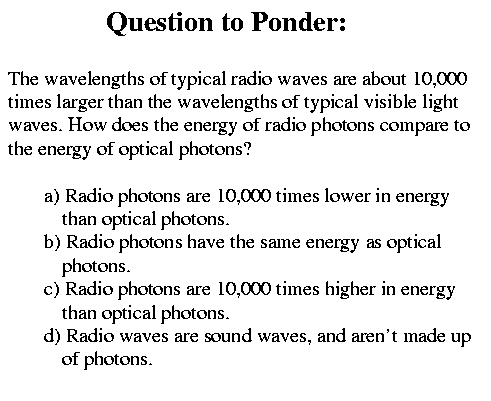|
|
Whenever life gets you down, Mrs. Brown,
and things seem hard or tough, and people are
stupid, obnoxious or daft and your feel
that you've had quite enough...
Just remember that you're standing on a planet that's evolving, Monty Python, Galaxy Song |
Assignments:Read Chapter 32, Sections 5 and 6 (pp. 530-533)
Problem Set #5
Check out these images of the dust betwen the stars in our galaxy |

In Class:
-------------------
review:
the galactic disk has lots of junk in it
- mostly gas and dust
- the density of this stuff is really low
- space is almost empty
- maybe 1 partilce per cubic cm
- compare with air: 10^19 particles per cc
- still because the galaxy is really big
- distances are really large
- even a low density of stuff starts to make a
difference in terms of visibility
- kind of a haze
- makes it hard to see distant objects
the dust in the galactic disk "hides" much of the galaxy from
our view in the optical
we have to look at longer wavelengths
- infrared and radio
- these kinds of light are less affected by dist
- penetrate further through the galaxy
- allow us to see a larger fraction of the galaxy
- in the infrared, we can see right through the galactic disk
- radio, too.
---------------------
This gas and dust isn't all bad, though
it's an important component to our galaxy
galaxy isn't just the stars in this system
it also includes this other stuff
and in fact, this other stuff plays a really important role
in the life of the galaxy
How can we study this stuff?
we can "see" the dust
- how it obscures background starlight in "clouds" of dust
- not just smoothly distributed in the galaxy
- pretty clumped into "clouds"
- it must be present on a massive scale
- hides from view more than half of the galaxy
(according to Shapley)
- confirmed by infrared observations
The role of radio and infrared astronomy in finding the structure of the Gax.
- radio and infrared waves aren't as scared of dust
- pass right through
- can see the whole galaxy
- also, basically everything emits radio waves
- radio waves -- really long wavelength (~1 cm)
Ephoton = hc/lambda
= 6.626e-34 3e-8/0.01 = 2e-23 Joules
- really low energy
- compare to an optical photon where E = 2e-19 Joules
- 10,000 times less energy
- don't need to be very hot at all to emit
- so basically everything emits radio waves
even if it doesn't emit optical light
- can detect the dust and cold gas between the stars
So everything in the galaxy emits radio waves
and radio waves can travel unimpeded to us
- sounds good?
- works great to detecting dust
- little tiny blackbody emitters
- pretty cold (T = 10-100 K)
- not too cold to give off radio and far-infrared
light, though
lots of strucutre in this stuff
but what about the gas?
- at moderate densities, gas doesn't obscure our view
- I'm looking at you through lots of gas right now
- how can we see gas?
- in lab, we found that gases (ie., material at low-ish densities)
emit in spectral lines
- so look for spectral line emission between the stars
- don't see any
- does that means there's no gas between the stars?
- possibly, but not necessarily
- there could be very little -- too little for us to detect
- or, the gas could be cold
- cold gas, atoms in ground state, no emission
- however, could see absorption
- point at a star
- look for absorptions from cold foreground gas
- see absorption; there's cold gas there
Absorption measurements are useful, but they're limited
- can only look in the direction of bright stars
- sometimes can confuse stellar spectral lines with
interstellar spectral lines
It would be a lot nicer if we could observe the gas in emission
but it's too cold for most of the gas to be excited
to the first electronic state (i.e., N=2)
We can, because electronic transitions are not the only way an
atom can change energy
- H emits in the radio via a wierd "spin-flip" transition
- p+ and e- both have spins
- like to spin in opposite directions
- can spin in the same directions, but it costs energy
- transition from up-up to up-down liberates energy
- tiny compared to electronic transition
- makes a radio wavelegnth photon
- long wavelength = low energy
The great thing about the H spin-flip transition is that it can occur at
really low energies
- energy difference between the real ground state and
the flipped state is:
E = h nu
= 6.626e-34 x 1.420406 x 10^9
= 9 x 10^-25 J (compare with optical photon - 10^19 J)
--> So it just doesn't take much to get the H atom into this excited state
- maybe a wimpy collision with another atom
- just a little bit of shaking
--> as a result, even really cold H gas has a bunch of atoms in
the excited state
-- so this emission is seen everywhere there's H
And it is seen everywhere in the disk of our Gax
--> the disk of the gax is filled with gas and dust as well as stars
- it really is a "filled" pancake
- if you think having approx 1 atom per cubic cm is filled
- density << the best vaccuum we can make on earth
- there's not much stuff in each bit of space
- but the amount of space we're talking about is
REALLY HUGE, so there's a lot of stuff in total.
- no "obscuration" from dust, so we can see the whole galaxy
|
![]()